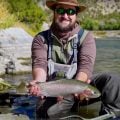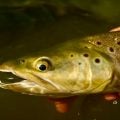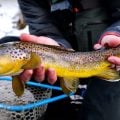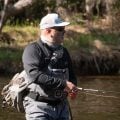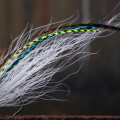How Do Peacock Bass Compare to Largemouth and Smallmouth?
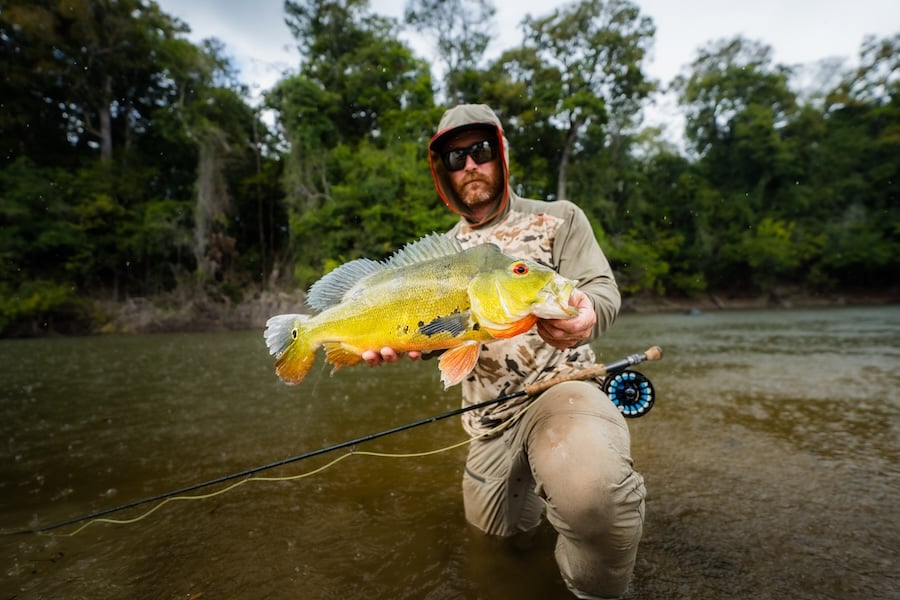
The author with a big butterfly peacock bass from Guyana. Photo: Jesse Males.
Anglers frequently ask how South American peacock bass compare to our smallmouth and largemouth bass here in the United States. You might distill the answer to: “strikingly similar, yet oceans apart.”
What’s in a Name?
The incorrigible fish nerd in me must first point out that peacocks and North American basses aren’t closely related—from an evolutionary, if not angling, perspective. While our smallies and largies are black basses of the Centrarchid family, “peacock bass” refers to some 16 members of the Cichlid family. Cichlidae includes some 1,760 freshwater documented fishes across Central and South America, Africa, Madagascar, the Middle East, and the Indian Subcontinent—one of the largest Linnaean families of vertebrates. It’s so diverse, in fact, that new species find their way onto the list every year. Some researchers believe there may be somewhere on the order of two or three thousand cichlid species in existence. Africa’s Lake Victoria alone contains more than 500 breeds.
Centrarchids, on the other hand, include only 34 extant species of black basses (including smallmouth and largemouth), sunfishes (think bluegills and pumpkinseeds), rock basses, and crappies, endemic to North America. They diverged from Cichlids some 80 to 100 million years ago, likely coinciding with their respective continents drifting apart.
But the fact remains that we call peacocks, largemouths, and smallmouths “bass.” They’re similarly shaped—with thick, round bodies; dorsal spines; and wide, hinged jaws—perhaps an example of convergent evolution. The same could be said of striped bass and the Moronidae Family. They’re fast, aggressive, charismatic, jump high, and punch a properly-placed popper like it owes them money.
Bigger and Badder
Brandon Powers, MidCurrent’s Travel Program Director, knows more than most about the distinction between the basses. He has been journeying from the reservoirs of Texas to the backwaters of Brazil most every year for 15 years, hosting and booking anglers into the T.C. Fishing Amazonas mobile, floating safari camp—pursuing some of the biggest peacock bass on Earth.
“People who love largemouth or smallmouth bass fishing are going to love peacock bass because there’s an air of familiarity there,” Brandon says. “But outside of physical similarities and similarities in prey, that’s kind of where it ends. The peacocks are so much more of an apex predator; they are so much more vicious and so much more powerful. They’re really like a saltwater fish that got trapped in the Amazon River. Pound for pound, they’re the toughest freshwater fish on the planet.”
Peacock Bass vs. Largemouth and Smallmouth Bass
“When you’re throwing a fly at a fish over 20 pounds and you’ve got 60-pound or heavier fluorocarbon leader and that fish just cleans you out on a 9 or 10 weight, there’s nothing you can do. It’s just a whole other animal,” Brandon says.
One thing anglers quickly notice in the Amazon Rainforest is just how much more charged-up the fishes feel in that perpetually warm and nutrient-rich water. They don’t need to conserve calories in the same way as their northern analogs. They’ll still shut down for various reasons, but the fight in them does not. They pull harder and jump higher—and this is coming from someone who holds smallmouth in the highest of regard.
Cichla temensis, speckled or three-bar peacock bass, is not only the largest peacock, but also one of the largest of all the cichlids worldwide. With recorded monsters approaching 40 inches and 30 pounds, these beasts might be better compared to permit for a fly angler.
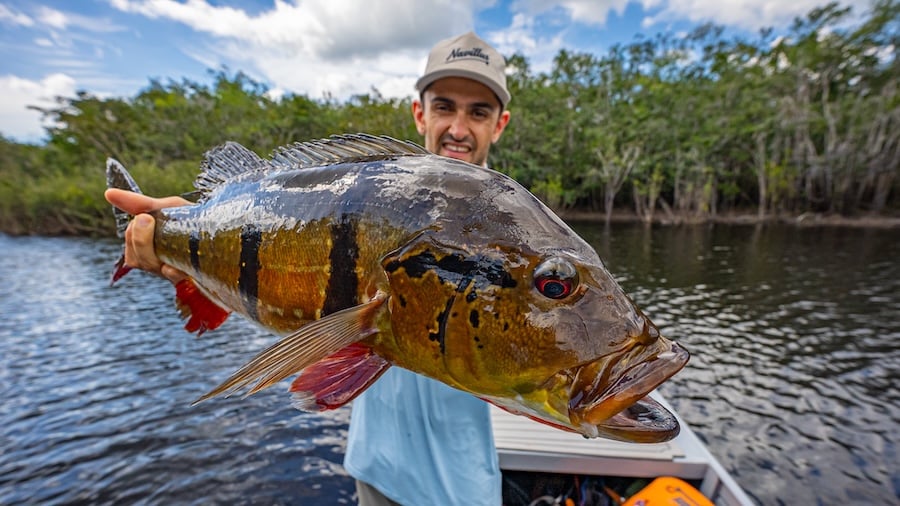
Photographer Dan Favato with a three-bar peacock bass. Photo: Brandon Powers.
On the other hand, the butterfly peacock bass, Cichla ocellaris—the species introduced in Florida and elsewhere—runs a much more manageable and familiar bass size, up to 10 or 12 pounds. This species is concentrated in the Guianas, the northern countries of South America that drain into the Caribbean rather than the Amazon—especially including the Rewa River where I lead expeditions annually for peacocks, payara, and arapaima up to 400 pounds. A new, larger species of lower in the Essequibo Basin—falls lukunani or Cichla catactae—was only described by scientists for the first time in 2020. Most of the other species sit somewhere between these poles, carving their own niches and color schema.
While our black basses boast cryptic, muted colorations of green and bronze, peacock bass are anything but drab. Defined by their brilliant yellow, orange, red, green, blue, purple, and black hues, these fishes earn the comparison to their eponymous bird. That bright plumage similarly comes into play during mating season, when males also develop the iconic nuchal hump on their forehead. Imagine, if you will, a big smallmouth doubled in size and dressed for Mardi Gras.
Conventional vs. Fly for Peacock Bass
While the delicacy and finesse of fly tackle might be advantageous for some Amazonian species—think herbivorous pacu or spooky arapaima—like largemouths, peacock bass can be inclined toward the fast, the flashy, and the loud.
“A plug fisherman has a distinct advantage in that he can throw a woodchopper or a wide glide or a bait that’s 10 inches long and entice one of those really big 20- to 30-pound fish into eating,” Brandon says. “For fly guys, it takes a little more coaxing and a little bit better presentation. The flies are not as big, they’re not as loud, and they don’t they don’t attract fish from a distance the way that uh that a noisy topwater would.”
That said, the ability to quickly and accurately pick apart structure and seductively pause a fly in front of a curious fish is exceptionally effective.

The Amazon Rainforest shares its unparalleled scenery. Photo: Dan Favato.
“You work a little bit harder or a lot harder to get those really big fish,” Brandon says. “But through the course of the day, a fly guy is going to go catch, if he’s decent at all, 30 to 100 peacocks, whereas a plug guy is going to catch considerably fewer. He may have a better chance at that bigger fish, but he’s not going to catch as many.”
Peacock Bass Habit and Habitat
While the Spanish gave us pavon or “peacock” from the feather fan-like eyespots on these fishes’ tails, the Brazilian Portuguese tucunaré comes from the indigenous Tupi title, “friend of the tree.” They are rarely found far from woody structure, certainly reminiscent of their northern neighbors. Peacock bass often ambush prey from cover—and if not, may corral bait against it when hunting in packs.
“If you’re used to your local bass lake or bass river back home, it’s gonna feel real familiar,” Brandon says. “You’ve got points and flooded cover, whether that’s trees, logs, sandbars, rocks. If you’ve got a little bit of fishing experience, you’re going to be able to discern some of the spots with higher likelihood of holding fish.”

There’s rarely a shortage of fishy cover and coves in the Amazon tributaries. Photo: Dan Favato.
Brandon says that comparing peacocks to Esox—pike and musky—might actually be more apt. They’re not afraid of the leader, not afraid of the boat, and will often track a fly to the rod tip out of sight. His first and biggest fish on his most recent trip with T.C. Fishing came after a client asked him to demonstrate the proper retrieve. A 20-plus-pounder a few centimeters short of the world record ate at the rod tip, middle of the boat, as Brandon swept through in figure-eight fashion. Classic musky bite.
Gearing Up for Battle
“Peacocks are a little bit different in that they don’t tend to go down for a bait very well,” Brandon says. “A lot of guys are used to catching bass on heavy jigs, heavy flies on the bottom, or soft plastics. Not only would you not want to fish that stuff because of toothy fish—you’ll lose tails on every cast—but peacocks, for whatever reason, are not inclined to look downward. They don’t mind coming up in the water column for a bait, but it’s really hard to get them to go down for something.”
Baitfish patterns rule the roost, with trophy anglers employing some of the same flies they might otherwise throw toward roosterfish, striped bass, or giant trevally. Brandon swings for the fences with 4/0 to 6/0 hooks and the profile and bulk that goes on those big irons.
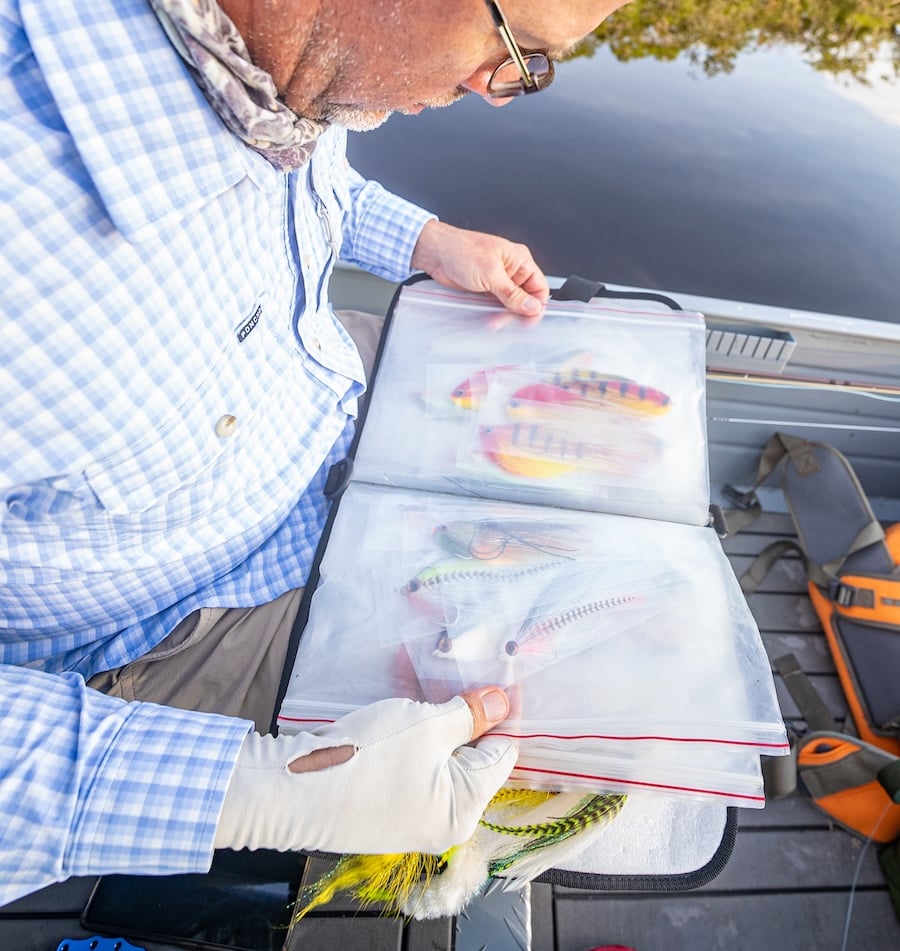
Brandon carries a wide selection of big streamers to accommodate for conditions and picky fish. Photo: Dan Favato.
You’ll likely see more chartreuse and bright orange in a peacock bass box than in a largemouth selection, given the brighter complexion of many food fishes in these systems. While dark and/or drab colors have their place, flashy and bright puts off a glow in the tannic waters almost synonymous with peacock territory. When you’re covering miles of river or lagoon looking for that one giant, your offering should be as visible as possible.
And it would be a grave error to take your first trip to the jungle without a healthy selection of big topwater bugs. It’s what peacocks are famous for, after all. Poppers, divers, gurglers, wiggle bugs, snakes, and lizard patterns are sometimes even more productive than subsurface presentations. Nothing makes more noise than repeatedly breaking the surface tension, and jungle predators are always listening for food to drop from the forest.
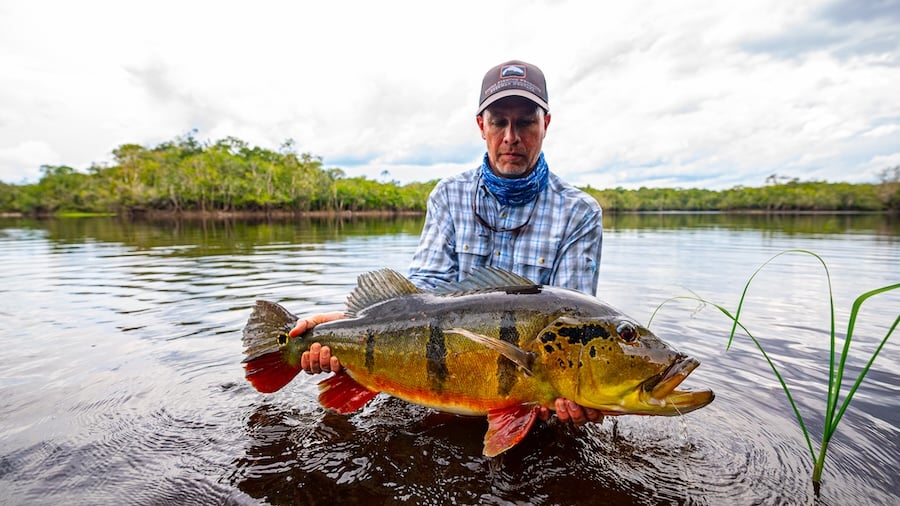
But while peacocks are highly opportunistic and sometimes violently grabby, it doesn’t mean you can throw any old beater bug if you want to see a real monster.
“They didn’t get that big by being dumb, and even though these fish are unpressured, they’re still creatures of habit,” Brandon says. “So, if your fly’s not tracking straight, if it’s moving too slowly, if it doesn’t look quite right; I wouldn’t say they’re picky about pattern, but if something’s off, they might be apprehensive.”
Butterfly peacock bass are an ideal 8-weight fish. Three-bar peacocks might make a mockery of the same rod. Brandon prefers stouter 9- and 10-weights, even reaching for the 11-weight rigged for arapaima on some occasions. The jungle is hard on graphite, so consider bringing the stick you’d use for beach-based salmon or stripers rather than the fine permit piece.

Wolf fish or aimara are one of many exciting species you may encounter while pursuing peaocks. Photo: Dan Favato.
Aggressive weight-forward floating lines are standard for topwater and shallows, while clear-tip intermediate lines often perform best for general streamer applications. Forty- to 80-pound fluorocarbon is the correct call for the terminal end; heavier but not unlike how you might approach double-digit Texas or Florida largemouths around the same kind of nasty cover. Everyone is shocked by how hard big peacocks hit and run.
I could end by saying that if you like fly fishing for smallmouth and largemouth bass or muskellunge, you’re going to love peacock bass—but I’m sure you already knew that. Even still, it’s hard to comprehend the Amazon Rainforest and its fishes until you see them for yourself.
For more information about peacock bass trips,
call or email Brandon Powers at Midcurrent Travel:
1 (817) 455-5374 or [email protected]
MidCurrentTravel offers bookings and annual hosted trips to Brazil and Guyana.
Please reach out if you have any questions!
